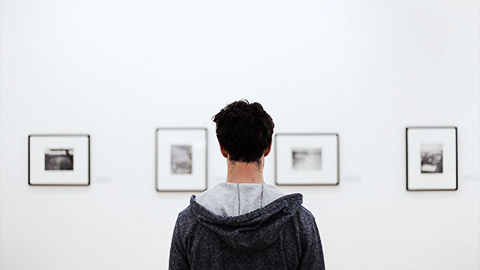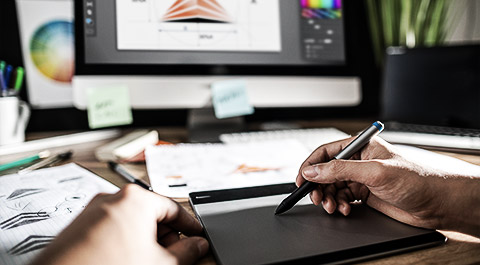Welcome to topic 4 – Develop individual approach to use of drawing. In this topic you will learn to analyse the effectiveness of drawing to communicate ideas and act as a tool that supports professional practice.
You will be introduced to the following topics:
- Evaluate the success of completed drawings in communicating ideas
- Evaluate the process of drawing and visual representation as a professional practice tool
- Determine the value and place of drawing and visual representation in own practice based on experimentation

It is important to evaluate how successful your completed drawings are in communicating ideas. You can do this in a variety of ways, including through critical reflection and by seeking feedback:
Critically reflecting on your work
It is important to critically reflect on the drawings and other visual representations you create – and how successful they are in communicating concepts (e.g. messages, emotions, ideas,). Your aim is to identify gaps and inadequacies in this process. Where you identify gaps/inadequacies:
- You can address these, to improve the current art or design wok you are creating
- You can take action to ensure similar gaps/inadequacies do not recur in your future work
Developing reflective practice involves asking yourself what worked, what didn’t, and what you would change for a better outcome in a particular situation. By effectively assessing your own and other's practice, you will gain new skills and knowledge. Turning reflection into a habit takes practice, but once mastered it will give you greater confidence in all your judgements.8
You may reflect in a number of different ways. Reflection may involve thinking back on your work at a later time, or speaking about your work with your other peers, work supervisors, managers, etc. Reflection may involve writing about your work. You may participate in formal performance reviews.
Seeking feedback on your work
Once you have produced a piece of drawing work, you should discuss its effectiveness with relevant people – for example: your supervisor/trainer, your colleagues, your client (if relevant), art and design industry experts, etc. Your aim is to seek feedback about how effective your use of techniques, tools and materials are at communicating ideas, and areas where you can improve.
Feedback is, essentially, information which you – and others – can use to improve your work:
We do not have to agree with people’s perceptions but it is important to be aware of them. It is useful information that can inform our decisions and strategies.
Working without feedback is similar to setting out an important journey minus a map or signposts. You may have a great sense of direction but this may not be sufficient to keep you on track. When people receive little feedback, they tend to either be overly self-critical or self-congratulatory. This is because they are relying upon events rather than specific feedback to measure their performance and impact.9
You can seek feedback from people in a variety of ways – consider the following:
- By asking for feedback directly, either verbally or in writing – for example:
- ‘Please tell me what you think of this work?’
- ‘Is there anything in this work that needs to be changed? How? Why?’
- By observing how people use or interact with the artwork or designs you create
- By listening to comments from managers, colleagues and clients
It is important that the feedback you receive from others is considered objectively. This means you should look at the feedback in an impartial, detached and unemotional way, consider its value, and determine whether it is worth acting upon and using. Consider the following statement:
Although all feedback – and particularly critical feedback – is valuable, it is important to remember that in most cases feedback is just somebody’s subjective opinion. It is therefore important that you evaluate others’ ideas and opinions, as reflected in their feedback. As yourself questions such as:
- Is this feedback relevant to me? Is it credible, and justified?
- Is the person giving me this feedback qualified to do so?
- What is motivating this feedback?
- Can I use this feedback?
- Will this feedback be useful in helping me to improve my drawing work?
Where you determine that feedback is worth acting upon, use it to improve the drawing and visual representation work you create. Continuously seek feedback to continuously improve your work.

As you saw in an earlier section of this unit, drawing and other visual representation tools can be used in a variety of ways to support your own practice. It is important to evaluate the process of drawing and visual representation as a professional practice tool, and to determine the value and place of drawing and visual representation in your own practice. Again, this will enable you to use drawing and visual representation tools more effectively in your work to communicate ideas.
Evaluate the process of drawing and visual representation
How useful drawing and other visual representation processes are as professional practice tools ultimately depends on your work context, your role and the types of tasks you perform. In order to evaluate the processes of drawing and visual representation as a professional practice tool, ask:
- Will drawing and visual representation enable me to communicate the types of ideas I create? Are there more effective or appropriate strategies to communicate my ideas?
- Are drawing and visual representation considered acceptable by the people I work with? Will the people I work with be able to use and work with drawings and visual representations?
- Are drawing and visual representation used routinely in my workplace or my industry?
Determine the value and place of drawing and visual representation
Again, the value and place of drawing and visual representation in your own practice ultimately depends on your work context, your role and the types of tasks you perform. In order to determine the value and place of drawing and visual representation in your professional practice, ask:
- How could I use drawing and visual representation to communicate ideas in my work?
- Are there situations in my professional practice where drawing and visual representation will enable me to perform my work tasks more effectively than I currently do so?
- How do others in my workplace or my industry use drawing and visual representation? Do they use drawing and visual representation effectively, or are there other options?
Drawing as a tool in professional practice
As a result of your evaluation and experimentation, you may determine:
- Drawing and visual representation are useful as a professional practice tool, and can therefore be used routinely in your own practice to effectively communicate ideas
- Drawing and visual representation are somewhat useful are a professional practice tool, and can therefore be used as appropriate in your own practice to effectively communicate ideas
- Drawing and visual representation are not as useful as other approaches, and should therefore only be used when they are the most suitable approach or the only option
